

Scientists Discover Immune Cell That Kills Most Cancers. A newly discovered immune cell could lead to the creation of a universal cancer treatment — a “Holy Grail” treatment that would work for all cancers, in all people.
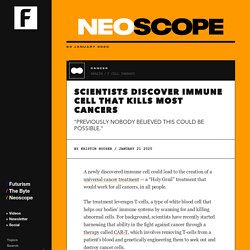
The treatment leverages T-cells, a type of white blood cell that helps our bodies’ immune systems by scanning for and killing abnormal cells. For background, scientists have recently started harnessing that ability in the fight against cancer through a therapy called CAR-T, which involves removing T-cells from a patient’s blood and genetically engineering them to seek out and destroy cancer cells. Scientists Place Humans in “Suspended Animation” for First Time.
This girl’s dramatic story shows hyper-personalized medicine is possible—and costly. When six-year-old Mila Makovec was diagnosed with a devastating neurological disorder called Batten disease, the happy, active girl had already lost her ability to see, to say most words, and to walk without help.

There was no known treatment for her fatal condition. Then, in a dramatic demonstration of the power of personalized medicine, doctors in Boston created a treatment just for her. In only eight months, they found the genetic cause of Mila’s disease, designed a drug to overcome the error, and began giving it to Mila via an injection in her spine, in what’s believed to be the first individually tailored treatment of its kind. Twenty months after Mila started receiving the drug, her mother, Julia Vitarello, and the doctor who helped her, Timothy Yu of Boston Children’s Hospital, say that the personalized treatment was partly successful. It has lessened Mila’s seizures, and she can eat pureed foods on her own rather than always using her feeding tube. What Does the Future of Biotechnology Therapies Look Like? Biotechnology is still a relatively new field with great potential for driving medical progress.

Much of that progress is likely to result from advances in personalized medicine. This new treatment paradigm aims to ensure that patients get the therapies best suited to their specific conditions, genetic makeups, and other health characteristics. Surgeon Transfers Nerves to Let Paralyzed Patients Use Hands. Previously Paralyzed Natasha van Zyl has dramatically improved the lives of 13 people — by moving their nerves around.
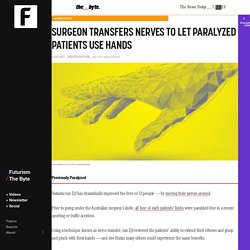
Prior to going under the Australian surgeon’s knife, all four of each patients’ limbs were paralyzed due to a recent sporting or traffic accident. Using a technique known as nerve transfer, van Zyl restored the patients’ ability to extend their elbows and grasp and pinch with their hands — and she thinks many others could experience the same benefits. Nerves of Steel She and her team at Austin Health in Melbourne, Australia, started by removing functional nerves from above the patients’ spinal injuries. Two years after the surgeries, according to the paper, the patients showed significant improvement in their hand function.
Scientists Gene-Hack Viruses to Hunt and Kill Super-Strong Bacteria. Handheld CRISPR Device Diagnoses Genetic Disease in 15 Minutes. Doctors Wired a Prosthetic Hand Directly Into a Woman’s Nerves. Sans Hand In a world first, doctors in Sweden say they’ve wired a prosthetic hand directly into a woman’s nerves, allowing her to move its fingers with her mind and even feel tactile sensations.
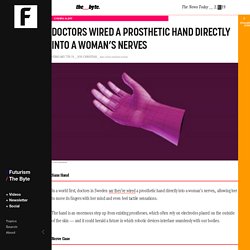
The hand is an enormous step up from existing prostheses, which often rely on electrodes placed on the outside of the skin — and it could herald a future in which robotic devices interface seamlessly with our bodies. Nerve Case Researchers at Chalmers University of Technology and biotech firm Integrum AB created the prosthetic hand as part of DeTOP, an ambitious European research program on prosthetic limbs. Delivery of 45 Age Reversing Gene Therapies at Once is Under Peer Review. Building the Tricorder: The race to create a real-life Star Trek medical scanner.
Its vision of romantic encounters with aliens and plagues of tribbles may not have come to pass just yet, but Star Trek has proved surprisingly accurate in predicting the future in other ways.
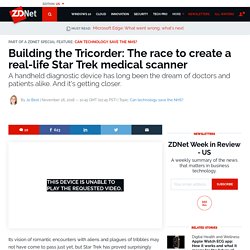
When it comes to technology, the show's gadgets have already become reality in several cases: its communicator predicted the clamshell mobile phone, the food replicator was made real with 3D food printing, and Captain Kirk was using voice input long before Alexa became a household name. "Synthetic Skin" Could Give Prosthesis Users a Superhuman Sense of Touch. Today’s prosthetics can give people with missing limbs the ability to do almost anything — run marathons, climb mountains, you name it.

But when it comes to letting those people feel what they could with a natural limb, the devices, however mechanically sophisticated, invariably fall short. Now researchers have created a “synthetic skin” with a sense of touch that not only matches the sensitivity of natural skin, but in some cases even exceeds it. Now the only challenge is getting that information back into the wearer’s nervous system. When something presses against your skin, your nerves receive and transmit that pressure to the brain in the form of electrical signals. 'The right trousers': Wallace and Gromit inspire artificial muscle clothing. Smart trousers with artificial muscles have the potential to improve the lives of people with mobility problems, say researchers.
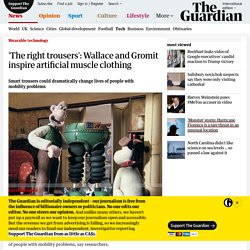
Inspired by the Wallace and Gromit clay animation The Wrong Trousers, the garb has been dubbed “the right trousers”. Jonathan Rossiter, a professor of robotics at the University of Bristol who is leading the project, demonstrated components of the trousers at the British Science Festival, taking place in Hull this week. The robot will see you now: could computers take over medicine entirely?
Like all everyday miracles of technology, the longer you watch a robot perform surgery on a human being, the more it begins to look like an inevitable natural wonder.

Earlier this month I was in an operating theatre at University College Hospital in central London watching a 59-year-old man from Potters Bar having his cancerous prostate gland removed by the four dexterous metal arms of an American-made machine, in what is likely a glimpse of the future of most surgical procedures. Working, Beating Hearts Will Soon Be 3D-Printed From Patients’ Own Cel. Inside a lab that will open in a couple of months in Chicago, a biotech startup will soon begin perfecting the process of 3D-printing human hearts that could eventually be used in transplants.
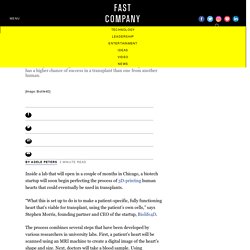
“What this is set up to do is to make a patient-specific, fully functioning heart that’s viable for transplant, using the patient’s own cells,” says Stephen Morris, founding partner and CEO of the startup, Biolife4D. The process combines several steps that have been developed by various researchers in university labs.
First, a patient’s heart will be scanned using an MRI machine to create a digital image of the heart’s shape and size. Next, doctors will take a blood sample. Using techniques that have been developed over the last decade, the blood cells will be converted into stem cells–and then converted a second time into heart cells. Your Future Doctor May Not be Human. This Is the Rise of AI in Medicine. Diagnosing with “The Stethoscope of the 21st Century” A new kind of doctor has entered the exam room, but doesn’t have a name.
In fact, these doctors don’t even have faces. Artificial intelligence has made its way into hospitals around the world. Those wary of a robot takeover have nothing to fear; the introduction of AI into health care is not necessarily about pitting human minds against machines. AI is in the exam room to expand, sharpen, and at times ease the mind of the physician so that doctors are able to do the same for their patients. Bertalan Meskó, known better as The Medical Futurist, has called artificial intelligence the “the stethoscope of the 21st century.” That’s where having the 21st century stethoscope could make all the difference. Gene Therapy for Blindness Approved by FDA in Groundbreaking Moment for DNA-Based Medicine. The Food and Drug Administration approved a groundbreaking gene therapy to treat a rare form of blindness Wednesday.
The drug, Luxturna, is intended to treat a genetic form of blindness called retinal blindness that affects about 1,000 to 2,000 people in the United States. The price of the treatment—widely speculated to be $1 million—will not be announced until early January, according to a spokesperson. "It really is a trailblazer for using gene delivery," Stephen Rose tells Newsweek. Rose is the chief scientific officer of the Foundation Fighting Blindness, which funded some of the preliminary research on the therapy.
(The treatment, first developed at the Children's Hospital of Philadelphia, has been licensed to Spark Therapeutics.) On Flipboard. On Flipboard. Student discovers a way to destroy superbug bacteria without antibiotics. A 25-year-old student has discovered a way to destroy antibiotic-resistant bacteria without pummeling them with more antibiotics. Shu Lam successfully destroyed superbugs in lab tests using a star-shaped polymer that literally rips the cells to shreds. This breakthrough could signal a complete overhaul in how the medical community approaches these deadly bacteria. Currently, antibiotic-resistant bacteria, including Methicillin-resistant Staphylococcus aureus (MRSA), kill 700,000 people per year.
The Future of Vision and Eye Care. Researchers estimate that 80-85 percent of our perception, learning, cognition, and activities are mediated through vision. Compared to that, our hearing only processes 11 percent of information, while smell 3.5 percent, touch 1.5 percent and taste 1 percent. Five Ways Cell Phones Are Literally Changing Global Health. Infectious diseases have ravaged continents, treatment-resistant superbugs are on the rise, and social stigma inhibits treatment of crippling psychiatric disorders. Nerve implant 'restores consciousness' to man in persistant vegetative state. Researchers Have Found a New Way to Delay Age-Related Health Decline. Birth of CRISPR'd pigs advances hopes for turning pigs into organ donors. This Magical-Sounding Nanochip Can Heal Wounds With A Single Touch. Researchers have developed a groundbreaking new device that can develop new cells within a patient’s own body, simply by acting on the skin.
Topical tissue nano-transfection mediates non-viral stroma reprogramming and rescue. CRISPR Skin Grafts Could Replace Insulin Shots For Diabetes. Deadly gene mutations removed from human embryos in landmark study. Scientists have modified human embryos to remove genetic mutations that cause heart failure in otherwise healthy young people in a landmark demonstration of the controversial procedure. 33 blood-cancer patients have dramatic clinical remission with new T-cell therapy. A Bioengineered 'Pancreas' Has Ended One Diabetic's Need For Insulin. In Brief A year after receiving a new type of islet cell transplant to treat her severe diabetes, a patient continues to do well and no longer needs insulin injections to manage her disease.
Scientists Found a Way to Radically Reduce Scarring, Thanks to Sea Creatures. Star Trek Qualcomm Tricorder XPRIZE Winner Announced. News: The Blog. Artificial Lung Keeps Woman Alive for 6 Days After Both Lungs Removed. A Baby With Three Parents Was Just Born. The Technological Future of Surgery - The Medical Futurist. Forbes Welcome. Top 20 Medical Technology Advances: Medicine in the Future.
3-D imaging of muscles points to potential treatments for muscle diseases and injuries - Scienmag. The science world is freaking out over this 25-year-old's answer to antibiotic resistance. Regenerative Biology: Scientists Discovered A New Molecule That Regenerates Bone Tissue. Theranos Had a Chance to Clear Its Name. Instead, It Tried to Pivot. Robots Could Be Performing a Third of U.S. Surgeries by 2021. English Scientists Make Breakthrough In Fight Against Antibiotic Resistance.
Dental Fillings Heal Teeth With Stem Cells. Imagine a blood supply without needles- Nikkei Asian Review. Canadian Doctors Successfully Reverse Severe MS Using Stem Cells. New CRISPR system for targeting RNA - Science and Technology Research News. Breakthrough method means CRISPR just got a lot more relevant to human health. Easy DNA Editing Will Remake the World. Buckle Up.
Total (Un)Recall—Scientists Are Erasing Painful Memories. Toward genome editing and a lot of cured diseases at Editas and other genetic companies. Scientists Grow Mini-Organs From Cells That Were Genetically Manipulated. Scientists unveil the 'most clever CRISPR gadget' so far - STAT. New Alzheimer’s treatment fully restores memory function. Neurophage Pharma may be able to treat Alzheimers, Parkinsons, Huntingtons and other brain diseases. Scientists Just Removed HIV from Human Immune Cells Using CRISPR Gene-Editing. Surgeons implant bioengineered vein: Kidney dialysis patient first in U.S. to receive lab-grown blood vessel.
Australian scientists offer new hope for paraplegics. This NASA-Tech Health Scanner Might Be The Closest Thing To A Real-Life Tricorder Yet. CRISPR Gene Editing Used to Repair Blindness-Causing Genetic Defect. CRISPR Successfully Treats Muscular Dystrophy in Adult Mammals For the First Time. A head transplant surgery was performed on a Monkey and it caused no neurological damage which keeps human head transplant attempt on track for end of 2017.